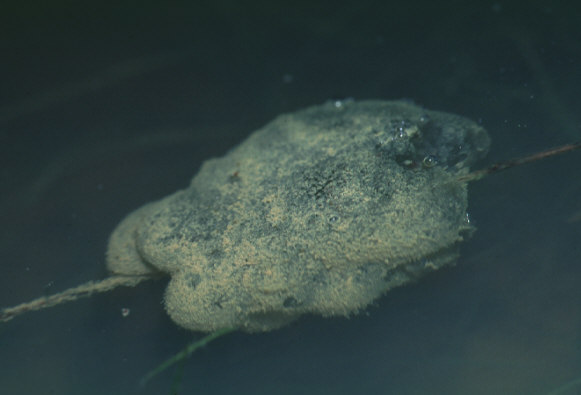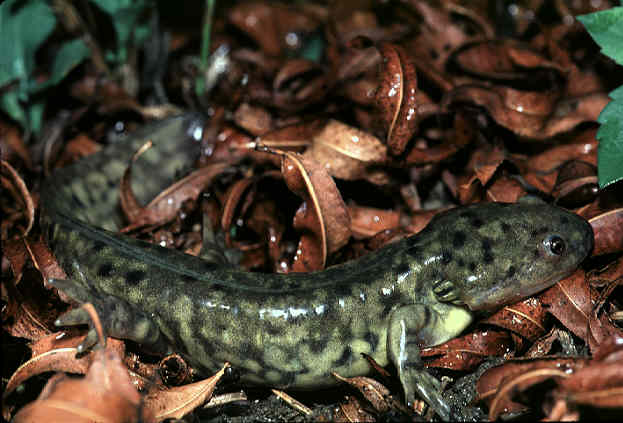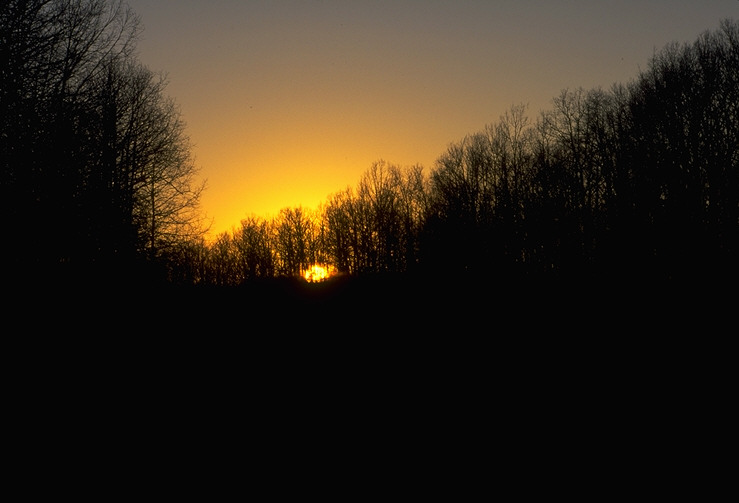|
Back
Tigers in the Pond Our pond never ceases to surprise us. It dried up this summer and much of the pond floor was covered with Spanish Needles. We removed some of the Spanish Needles but left the majority of them. Then, in October, after a few rains, about one inch of water covered the loblollied pond bottom. After hearing a strong Southern Leopard Frog chorus one night, we found Southern Leopard Frog egg masses in the shallow water, attached to the stalks of the dead Spanish Needles. (See 10/29/01 Nature Notes).
Afterwards, we received just enough rain to keep most of the egg masses in water until the tadpoles hatched. Then, on January 15th, we found Tiger Salamander egg masses in the pond, also attached to the stalks of the dead Spanish Needles. The week of January 21st, after all of the heavy rain, the pond completely filled. Hoping to see the adult Tiger Salamanders, we stood beside the pond in light rain at night, sweeping a flashlight across the bottom near the salamander egg masses.
Andrea saw the first one. An enormous Tiger Salamander, about 9 inches long was moving slowly through the water just a couple of feet from where we were standing. We were amazed at how large they were. Tiger Salamanders are among the largest terrestrial salamanders in the United States, rivaled only by the Pacific Giant Salamanders. We were struck by how different the Tiger Salamander looked in the water than on land, its keeled tail moving sinuously from side to side. It really looked like a serious predator making its way across the pond bottom. This adult, unlike the Tiger Salamander shown, was almost black, with bright yellow spots, a striking combination. Try checking a pond near you for Tiger Salamanders. Look for the egg masses attached to plant stalks near the pond edges. Other egg masses you might encounter this time of year are Spotted Salamander eggs, Wood Frog eggs, Southern Leopard Frog eggs and, in shallow water, Upland Chorus Frog eggs. To see photos of these eggs masses and who made them, click here.
The Woodcock's Call "This mysterious hermit of the alders, this recluse of the boggy thickets, this wood nymph of crepuscular habits is a common bird and well distributed in our eastern states, widely known, but not intimately known." So begins Arthur Cleveland Bent's description of the American Woodcock in "Life Histories of North American Shore Birds" (1927).
Few birds have as many aliases as the American Woodcock. Here are a few other names it is known by: Becasse (from the French, Becassine, a snipe), Big Eyes, Big-Headed Snipe, Big Mud Snipe, Blind Snipe, Bog Bird, Bog-Borer (from its way of probing the soft earth with its bill for earthworms, a favorite food), Bogsucker, Hookum-pake, Labrador Twister, Night Partridge, Night Peck, Siphon Snipe, Timber-doodle, Whistler, Whistling Snipe, Wood Hen and Wood Snipe. Whatever you call the bird, its dusk courtship flights during the winter months are a spectacle not to be missed. In "Birds of North America" (1895) Frank Chapman describes it well; " How many evenings have I tempted the malaria germs of Jersey lowlands to watch the Woodcock perform his strange sky dance! He begins on the ground with a formal, periodic, "peent," an incongruous preparation for the wild rush that follows. It is repeated several times before he springs from the ground and on whistling wings sweeps out on the first loop of a spiral which may take him 300 feet from the ground. Faster and faster he goes, louder and shriller sounds his wing-song; then, after a moment's pause, with a darting, headlong flight, he pitches in zigzags to the earth, uttering as he falls a clear twittering whistle. He generally returns to near the place from which he arose, and the "peent" is at once resumed as a preliminary to another round in the sky." To see the courtship flights, you must first find a calling territory. Listen at dusk and in the early evening along the borders of woods for the "peent" call. This call has been described in about as many different ways as the bird has names, but its call sounds similar to a Nighthawk's call, but thinner and more nasal. It might be easier for you to simply listen to a Woodcock we recorded while working in Cheatham county. Spring Peepers are calling in the background. Click here to listen. In Tennessee the courtship flights have been seen as early as October and as late as May. Typically, we start seeing them and hearing them around the middle of January. They seem to peak around the middle of February. This year we heard several courtship flights on January 23rd near Tullahoma and started hearing them on our farm a week later. On nights with a moon they may call long into the night. As for me, the Woodcock's courtship flight always sounds a little bit like a mechanical bird whose engine never has quite enough gas to complete its flight. The whirring wings sound like a tiny motor . As the bird reaches the apex of its flight the gas runs out, the engine skips and then picks back up again a couple of times, and then the bird dives for the ground as the engine sputters and misses. However you describe the Woodcock's courtship performance, the experience of quietly watching a sunset and the seeing the twilight flights is one of the wonders of the season. All photographs © 1999 LEAPS
|


